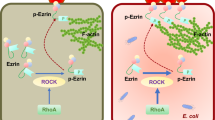Abstract
The effect of urinary tract infection (UTI) on mucosal damage and production of proteins promoting urinary stone formation has not been elucidated. Osteopontin production, with associated mucosal damage due to UTI, may allow easier crystal retention and nucleation resulting in stone formation. The aim of this study is to demonstrate that expression of osteopontin (OPN), OPN mRNA, TLR-4, JNK, TNFR-1, iNOS, HMGB-1, and apoptosis process is higher than normal at renal tubular cells due to urinary tract infection by Escherichia coli. Adult male New Zealand strain rabbits were used. Thirty New Zealand strain rabbits were divided into three groups. The first group acted as controls, the second group underwent ligation of right ureter, and the third group underwent ligation of right ureter and injection of Escherichia coli 105/ml proximal to ligation. Nephrectomy and histological examination were performed after 5 days. All groups were HE stained to examine mucosal damage, specific monoclonal antibodies for TLR-4, JNK, mRNA OPN, OPN, TNFR-1, iNOS and HMGB-1. Apoptotic nuclei were demonstrated using TUNEL method. Statistical calculations were performed using ANOVA test, with p < 0.05 considered significant. The findings confirmed the hypothesis that infection of urinary tract by Escherichia coli demonstrated higher expression of OPN, OPN mRNA, TLR-4, JNK, TNFR-1, iNOS, HMGB-1, apoptosis process and mucosal damage than normal. Infection of urinary tract by Escherichia coli caused higher than normal expression of promoter protein osteopontin and mucosal damage at renal tubular cells. These suggest that urinary infection may promote stone formation by mucosal damage and elevate promoter protein osteopontin at tubulus cell, allowing easier crystal retention and nucleation.



Similar content being viewed by others
References
Lopez M, Hoppe B (2010) History, epidemiology and regional diversities of urolithiasis. Pediatr Nephrol 25:49–59
Trinchieri A (2008) Epidemiology of urolithiasis : an update. Clin Cases Miner Bone Metab 5(2):101–106
Tosukhowong P et al (2007) Crystalline composition and etiologic factors of kidney stone in Thailand : update 2007. Asian Biomed 1(1):87–95
Verkoelen CF (2006) Crystal retention in renal stone disease: a crucial role for the glycosaminoglycan hyaluronan? J Am Soc Nephrol 17:1673–1687
Basavaraj DR (2007) The role of urinary kidney stone inhibitors and promoters in the pathogenesis of calcium containing renal stones. EAU–EBU update series 5:126–136
Klump DJ, Schaeffer AJ (2010) Induction and modulation of host responses by uropathogenic Escherichia coli structures. Urogenital Infections 2010. Arnhem, The Netherlands, VEAU–ICUD: pp 35–41
Evan AP (2010) Physiopathology and etiology of stone formation in the kidney and the urinary tract. Pediatr Nephrol 25:831–841
Hall PM (2009) Nephrolithiasis:treatment, causes, and prevention. Clevel Clin J Med 76(10):583–591
Kwon JH et al (2012) Impact of laboratory-reported urine culture colony counts on the diagnosis and treatment of urinary tract infection for hospitalized patients. Am J Clin Pathol 137:778–784
Al-Jebouri MM, Atalah N (2012) A study on the interrelationship between renal calculi, hormonal abnormalities and urinary tract infections in iraqi patients. Open J Urol 2:6–10
Thurgood Lauren A, Sørensen Esben S, Ryall Rosemary L (2012) The effect of intracrystalline and surface-bound osteopontin on the attachment of calcium oxalate dihydrate crystals to Madin–Darby canine kidney (MDCK) cells in ultrafiltered human urine. BJU Intern 109(7):1100–1109
Yamate T, Tsuji H, Amasaki N et al (2000) Analysis of osteopontin DNA in patients with urolithiasis. Urol Res 28:159–166
Wesson JA, Johnson RJ, Mazzali M et al (2003) Osteopontin is a critical inhibitor of calcium oxalate crystal formation and retention in renal tubules. J Am Soc Nephrol 14:139–147
Wullt B et al (2010) Immunity, genetic and susceptibility to urinary tract infection. Urogenital Infections 2010. Arnhem, The Netherlands, VEAU–ICUD: pp 23–31
Nelson KK et al (2006) Redox-dependent matrix metalloproteinase-1 expression is regulated by JNK through Ets and AP-1 promoter motifs. J Biol Chem 281(20):14100–14110
Hartwig WB, Wolfgang GB (2010) Immunology of the urinary tract. Urogenital Infections 2010. Germany, European Association of Urology, International Consultation on Urological Diseases: pp 42–56
Asselman M, Verhulst A, De Broe ME, Verkoelen CF (2003) Calcium oxalate crystal adherence to hyaluronan-, osteopontin-, and CD44-expressing injured/regenerating tubular epithelial cells in rat kidneys. J Am Soc Nephrol 14(12):3155–3166
Good DW, George T, Watts BA (2009) Lipopolysaccharide directly alters renal tubule transport through distinct TLR4-dependent pathways in basolateral and apical membranes. Am J Physiol Renal Physiol 297:866–874
Khan Fa, Khan MF (2010) Inflammation and acute phase response. Intern J Appl Biol Pharm Tech 1(2):312–321
Yang X, Zhao Y, Wang H, Mei Q (2007) Macrophage activation by an acidic polysaccharide isolated from Angelica sinensis (Oliv.) Diels. J Biochem Mol Biol 40(5):636–643
Cirl C et al (2008) Subversion of toll-like receptor signaling by a unique family of bacterial Toll/interleukin-1 receptor domain-containing proteins. Nat Med 14(4):399–406
Pollard TD, Earnshaw WC (2008) Programmed cell death. Cell biology. Saunders Elsevier, Philadelphia, pp 833–850
Orlova VV et al (2007) A novel pathway of HMGB1-mediated inflammatory cell recruitment that requires Mac-1-integrin. EMBO J 26:1129–1139
Khan SR (2004) Crystal-induced inflammation of the kidneys: results from human studies, animal models, and tissue-culture studies. Clin Exp Nephrol 8(2):75–88
Conflict of interest
None
Author information
Authors and Affiliations
Corresponding author
Rights and permissions
About this article
Cite this article
Djojodimedjo, T., Soebadi, D.M. & Soetjipto Escherichia coli infection induces mucosal damage and expression of proteins promoting urinary stone formation. Urolithiasis 41, 295–301 (2013). https://doi.org/10.1007/s00240-013-0577-4
Received:
Accepted:
Published:
Issue Date:
DOI: https://doi.org/10.1007/s00240-013-0577-4




